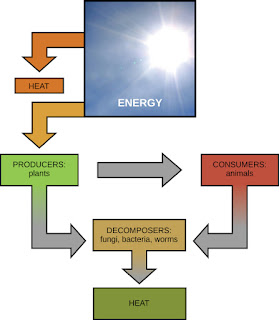Energy Generation and Utilization in the Living System
Energy is vital to life. Growth, reproduction and tissue repair require energy. Most organisms
obtain energy by oxidation of these fuel molecules Carbohydrates, fats and amino acids.
Cellular oxidation of these molecules release energy, part of which is conserved through the
synthesis of high-energy phosphate bonds and the rest is lost as heat. The high-energy
phosphate bonds are directly utilized for cellular energy requiring processes. ATP (adenosine
triphosphate) is the common high-energy phosphate bond that is formed during oxidative
processes.
Under cellular conditions energy releasing (oxidative) processes are coupled to energy requiring
cellular processes through common energy currency, ATP.
It is the universal transfer agent of chemical energy between energy-yielding and energyrequiring cellular processes. Other high energy triphosphates include GTP, UTP, and CTP
which are commonly used in biosynthesis (contain comparable energy to that of ATP).
ATP and other nucleotides of comparable energy, carry two high-energy phosphate bonds. The
hydrolysis of these high - energy phosphate bonds release energy which powers cellular energy
requiring processes. Thioester bonds also contain comparable energy content to that of ATP.
Energy of hydrolysis of thioester bond is mostly used to drive the reactions forward to
completion.
II- High-energy phosphate bonds
Fig 3.1 Structure of ATP
a) High-energy phosphate bonds:
- At pH 7, ATP
- carries four negative charges
- Charges repel each other because of proximity
- Repulsion is relieved upon hydrolysis of high-energy bonds
ATP and other high energy compounds contain phosphoanhydride bonds which release much
free energy upon hydrolysis
b) Energy of hydrolysis of phosphate bonds
hydrolysis of high-energy phosphate bond of ATP releases free energy of about -7.3 kcal/mol energy released upon hydrolysis of high energy phosphate bonds may result in:-
transfer of phosphate group with partial conservation of energy by newly formed bond
formation of new bond
change in conformation of molecules
signal amplification
transport molecules across membranes
some portion lost as heat (may contribute to body temperature maintenance in homoeothermic
organisms)
Hydrolysis of ATP or other nucleotides usually involves the terminal high-energy phosphate
bond. Similarly, phosphate transfer involves the terminal phosphate group. The phosphate
transfer also commonly involves the two terminal phosphate groups as pyrophosphate.
Transfer of AMP portion of ATP is also common with concomitant hydrolysis of pyrophosphate
(energy of hydrolysis driving the reaction forward)
C-Cellular formation and utilization of ATP
Within cells ATP is continuously formed and utilized
Serve as the principal immediate donor of free energy in biological system
* oxidation of fuel molecules
Catabolism of fuel molecules occurs stepwise each step releasing partial energy content of
molecules. The amount of total energy release depends upon the cellular conditions:
i-presence or absence of oxygen (aerobic or anaerobic)
ii-presence or absence of specific organelles with oxidative functions (mitochondrial)
Catabolic reactions in addition, provide building blocks for biosynthetic reactions
III- Catabolism of Fuel Molecules –An overview
a) Carbohydrates-digestion or mobilization of glycogen
Glycolysis- partial catabolism
- small amount of energy conserved (ATP, NADH)
- prepares carbohydrates for the next catabolic processes
- sometimes the only life sustaining energy generating process
- RBC (red blood cells-lack mitochondrion)
- exercising muscle (oxygen limitation)
b) Fats-digestion or mobilization of stored fat
Oxidation by major pathway → β Oxidation
No direct high–energy phosphate molecule is formed
c) Proteins-digestion or mobilization of tissue protein
During cellular oxidation of fuel molecules very little energy is directly conserved in the form
of high energy phosphate bond that can be directly utilized for cellular energy requiring
processes. Most of it is captured in the form of reducing equivalents such as NADH (reduced
nicotinamide adenosine dinucleotide) and FADH2 (reduced flavin adenosine dinucleotide).







